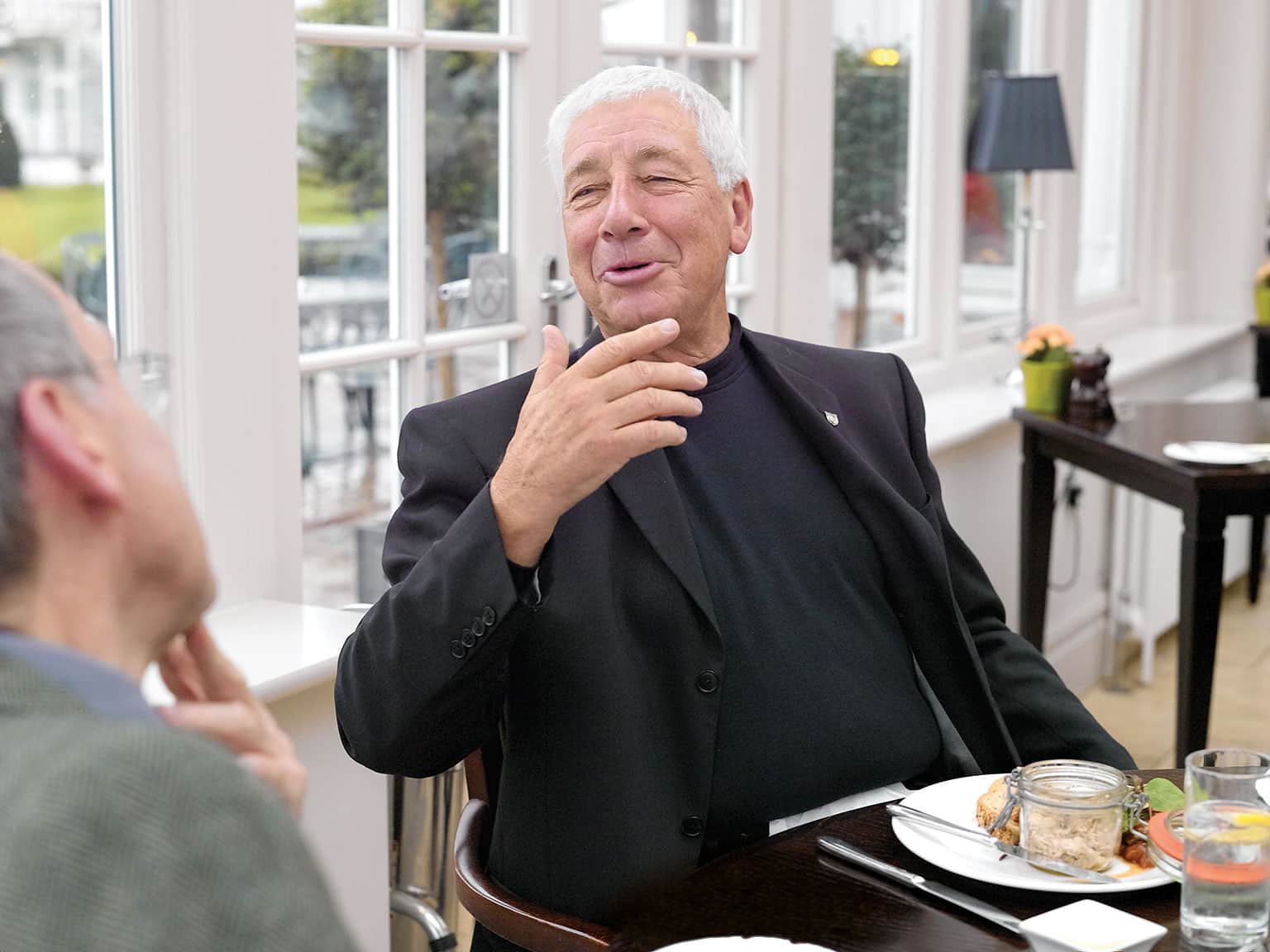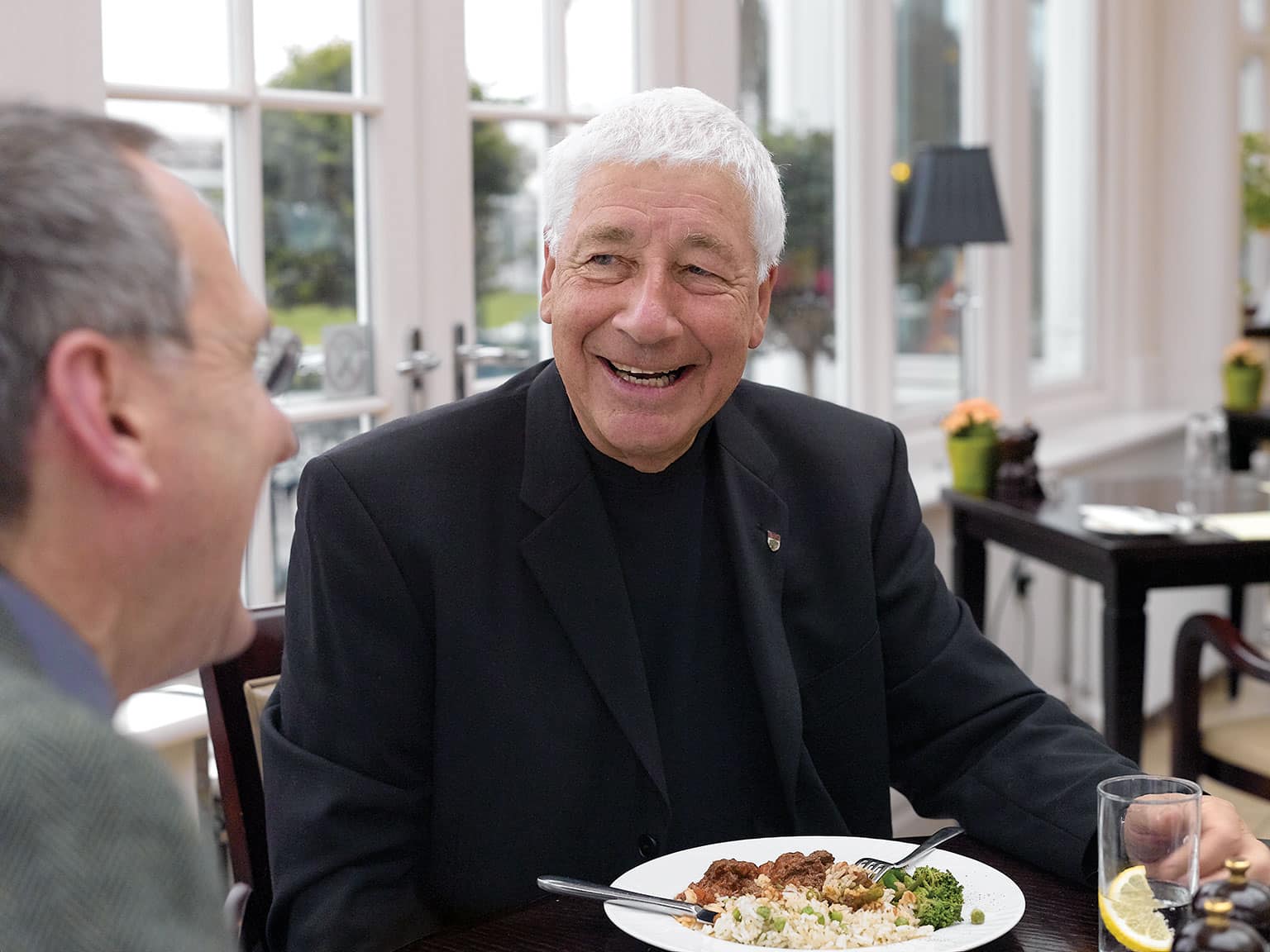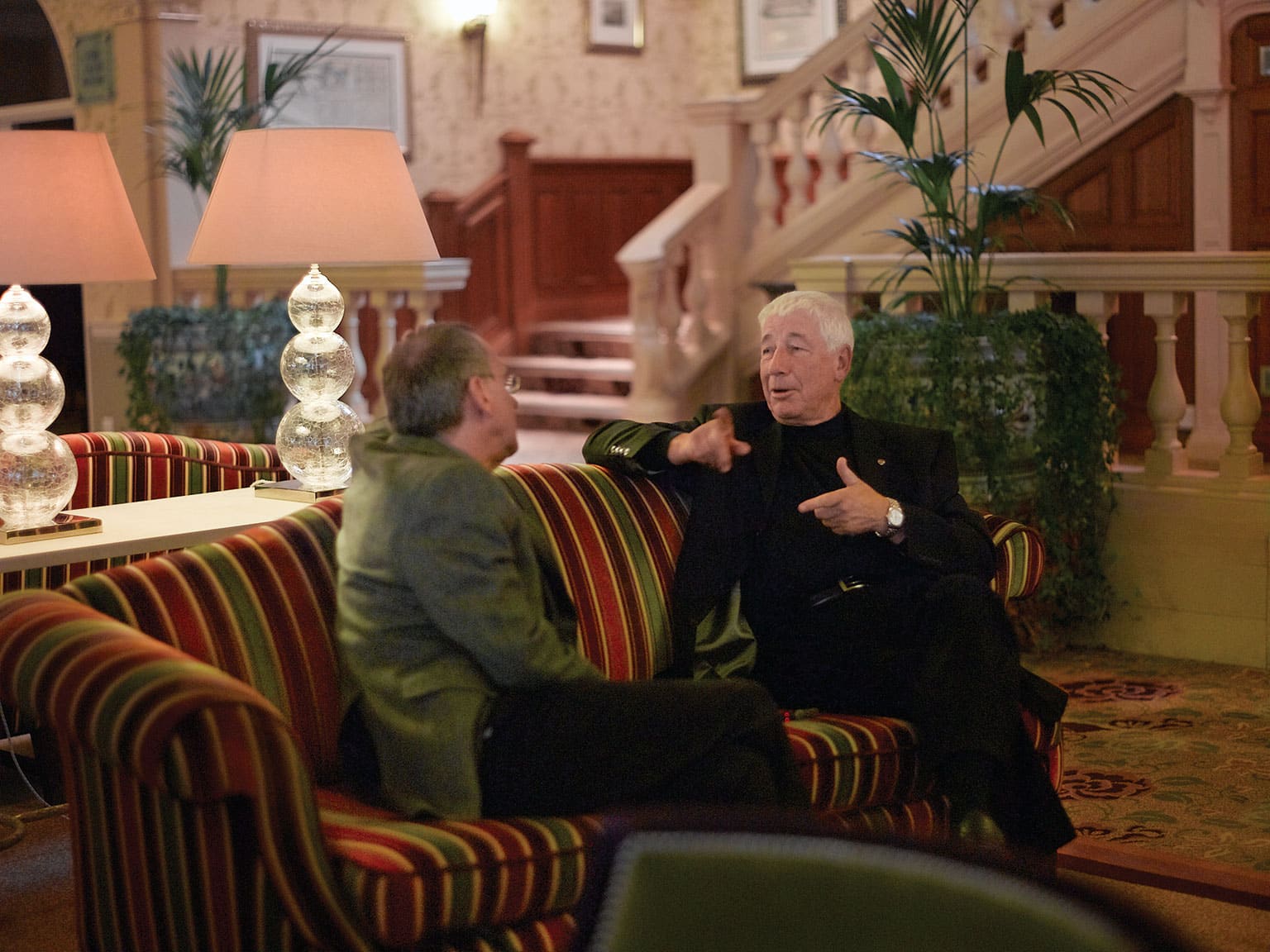He was born in 1941 in Hamilton, south of Auckland, eldest son of an agricultural engineer, and was barely aware of motor racing until he was taken to the 1955 New Zealand GP on the old Ardmore airfield circuit. “I had no idea what to expect, but when the flag fell and the two red Ferraris of Peter Whitehead and Tony Gaze came storming towards us, I found my religion. Until that moment I had no clue what I wanted to do with my life, but now I knew. I was going to be a Grand Prix driver. Of course, it didn’t turn out to be as easy as I’d hoped…
“To get involved, I started writing stories about local race meetings and sent them to Kiwi papers, then to Australian magazines, and finally to magazines in England. I decided to keep my real name for the famous driver I felt sure I’d become. I’d read stories by a Kiwi called Eoin S Young and thought his extra initial sounded grown-up, so I called myself James H Ganley. I was listed on the masthead of a short-lived English monthly called Sports Cars Illustrated as New Zealand Correspondent. I don’t think they realised I was a schoolboy. Then I showed my clippings to the local newspaper, and they hired me as a cub reporter. I was still only 15. But they made me write about produce markets and Red Cross fetes. To my disappointment they weren’t interested in racing cars.
“As soon as I could get a licence I did some local events in my mother’s Morris Minor, and I soon decided I needed a proper racing car. The only Lotus Eleven in New Zealand was for sale fourth-hand for £1300. I’d left the paper and was doing three jobs to fuel my motor-racing ambitions: on a construction site during the day, waiting tables in a restaurant at night, and pumping gas at weekends. I’d saved up £650, and persuaded my mother to lend me the rest. Soon after my 19th birthday I entered the Lotus for the 1961 NZ GP meeting at Ardmore, where six years earlier I’d first seen a racing car. In the sports car race I won my class, which got me £15. I thought, ‘I’m in the money now.’ And at the end of the day there was a race for New Zealand drivers only. I won that outright — and the prize money was £150. That got me to Levin, where I won a bit more, then on to Wigram and Invercargill. That went on for two seasons until, in the rain at Dunedin, I tried to take the fast uphill curve flat, and wrapped it round a telegraph pole. Johnny Mansel was killed that day — he hit a pole too, in his Cooper-Maserati — and Chris Amon collected one in his 250F.
“It was time to get myself to Europe. I sold the remains of the Lotus, paid off my debts, and had enough left for a slow boat to Lisbon, and then a bus to London. When I set foot on English soil, several months later, I had £25 in the world. But one person I knew was the New Zealand journalist Bill Gavin, who was now editing Autocourse. He introduced me to Mike Moseley, who ran the Falcon glassfibre bodyshell business and had built a neat little sports-racer with Terrier spaceframe chassis and 1100 Climax engine. Bill told him I was the fastest thing on four wheels, so Mike ran me in a race at Silverstone. I was going quite well until I spun, and I thought, ‘That’s blown that,’ but Mike said: ‘I’m going upmarket with a road car called the Falcon 515. Come and be my development engineer.’ I was 20, no job, no money, so I wasn’t about to say, ‘Development engineer? Me?’
“The deal was, as soon as I got the car into production, I could build up a lightweight version and race it. And to help build the cars I could get a friend over from Hamilton, John Muller, who was a brilliant mechanic. We found a bedsit over a railway line, ice on the inside of the window, single light socket hanging from the ceiling. There was a coin-slot meter, but we just plugged everything into that one light socket, because that was free, and put a six-inch nail across the fuse box.
“I really knew zip, and it was a steep learning curve at Falcon, but we got the car to the Racing Car Show at Olympia in January 1963. I did get to race the lightweight one, and went quite well against Jackie Oliver’s Marcos. But Falcon’s cash ran out, and they got in a new investor who vetoed all racing plans. So John and I left.
“Another Kiwi, Ross Grenville, was driving for George Henrotte’s Formula Junior team, until he had a big shunt at Aintree and lost part of a leg. Through Ross, John and I went to be race mechanics for George, who operated out of a corner of a garage in Bexleyheath. His drivers were Roy Pike, the American, and Syd Fox, and the car was the needle-nosed, twin-radiator Gemini, designed by Chas Beattie and built by Graham Warner’s Chequered Flag outfit. They hadn’t had much success with it, but John and I cleaned the cars up and got them going pretty well, and Pike scored a fine win at Crystal Palace. Then John rebuilt Pike’s engine, and we went to Brands on a public test day to run it in. It was pouring with rain, but George said to me, ‘Take it round for 10 gentle laps and bed it in.’ I did that, then George gave me another 10 laps at higher revs, and finally he told me to drive as hard as I liked, as long as I didn’t shunt it. I was quicker than everybody else in the rain, so George said, ‘We’ve got long-circuit Brands this weekend, but you can drive at Goodwood the weekend after.’
“Well, Brands was a disaster. There was a lap one pile-up, Syd was hit up the back, and Roy hit the bank and broke his leg. We loaded Syd’s car onto the top deck of our two-car van, the van driver went out to collect the wreck of Roy’s car — and forgot that the transporter was higher than the South Bank Bridge. So now we’ve got a wrecked transporter and two wrecked cars. And Goodwood was the following Saturday. I hardly went to bed that week, built a whole new front end onto the Pike chassis, John mended the Fox car, and we got to Goodwood for my first single-seater race. I was so tired I fell asleep on the grid. But I had a good dice with Paddy Driver’s Lotus 20, and finished fourth. A week later we were at the Niirburgring with most of FJ’s big names: Frank Williams, Charlie Crichton-Stuart, Pete Arundell and Mike Spence in the works Lotuses, and Jochen Rindt, who crashed his Cooper in practice. I finished 14th out of 41 starters. Then George’s sponsors pulled their money, the team folded, and I was out of a job again.
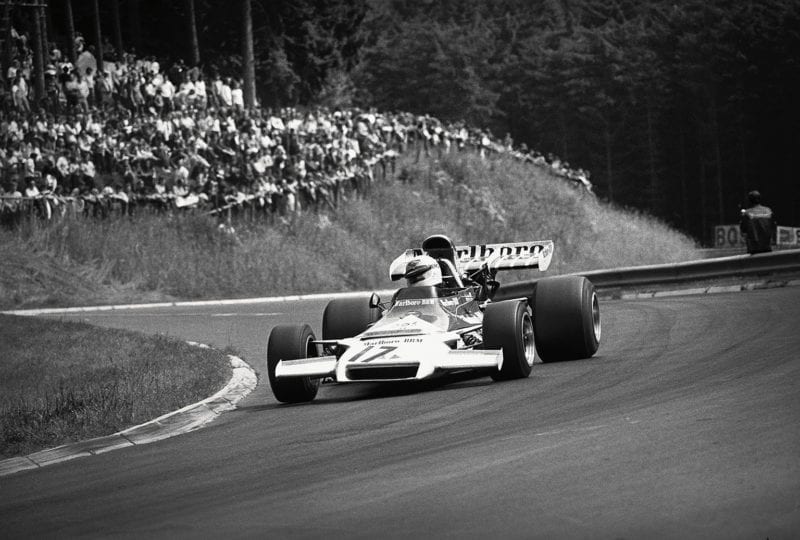
In 1972 German GP Ganley was a season-high fourth in BRM P160
Motorsport Images
“After a few miserable months — they say it’s always darkest just before dawn — I had a call from Eoin Young, who said, ‘Someone here wants to speak to you.’ And Bruce McLaren came on the phone. ‘I’m going to expand my team,’ he said, ‘and I want to hire Kiwis.’ So in June 1964 I became one of the first four employees of Bruce McLaren Motor Racing. There was Wally Wilmott, Tyler Alexander and me, plus Eoin as ‘secretary’, in a corner of a shed in New Malden full of earth-moving equipment: dirt floor, work bench, vice, set of welding bottles, a hacksaw and a file. Behind the diggers was the Zerex Special, which Wally and Tyler had just converted into the Cooper-Oldsmobile, and Bruce’s Tasman Cooper. Tyler and Wally said, ‘Why are you here?’ I’m a mechanic,’ I said. ‘No you’re not. We don’t know whether you can thread a nut on the end of a bolt. You’re a gopher.’ They had no chassis stands, and had to prop the cars on wooden crates, so they sent me over to Cooper to pinch lengths of tubing to make some up. ‘Don’t talk to old Charlie Cooper, he’ll tell you to f””” off. Talk to John.’ So I go to Coopers, find John, `G’day Mr Cooper, I work for Bruce, he said we could have some tubing.’ ‘That’s all right, boy, help yourself.’ So I get some tubing from the rack, and by the time I get back to New Malden it’s late and the others have left. I had no girlfriend to go home to, so I cut the tubing and welded up some nice chassis stands. Next morning Bruce and Tyler said, ‘Who did you get to do this? You mean you can weld like that? Right, you’re the fabricator.’
“In fact everybody did everything. My first job was to chop the back off the Tasman car to take a Hewland HD5 gearbox. To show you what Bruce was like, we were going up to Silverstone to test it and he said, ‘If you’ve got a helmet, bring it.’ We get there, he’s the driver, I’m the mechanic, he tests it, it’s going fine, and then he says, ‘Off you go.’ I’m lapping the GP circuit in a 2.7 Tasman Cooper. That’s the sort of guy he was. Of course it made you pull that much harder for him. Whatever it took, even three allnighters on the trot, you’d do it for Bruce.
“By the time we built the prototype McLaren, the Ml, which used Cooper corners and uprights, we were out of the dirt-floor shop and into a rented place in Feltham with a hard floor and proper work benches — real luxury. Teddy Mayer had joined by now to help Bruce run things, and eventually he became a partner. Teddy was a very intelligent guy, didn’t suffer fools, and he was obsessed with tidiness in the workshop. If you were making something and went home leaving your cut-out bits of metal on the bench, you’d come in next morning to find Teddy had been round with a rubbish bin, cleared your bench and thrown all the pieces away. You soon learned to keep a tidy bench.
“When they all went off to do the 1965 Tasman Series I stayed behind to build the first M1A. Johnny Muller, who’d been working during the season for Winkelmann Racing, needed a winter job, and the two of us built that car. Bruce had drawn the basic chassis frame, but he hadn’t had time to think about any of the details, the hundred and one widgets and brackets any car needs. Like gear linkage, or pedals. There were no drawings, so I worked it out in my head, cut the metal, and made them. During the night a draughtsman came in, looked at what I’d made and drew it for the production cars. That’s how racing cars were built in those days. You just got on and made the thing.
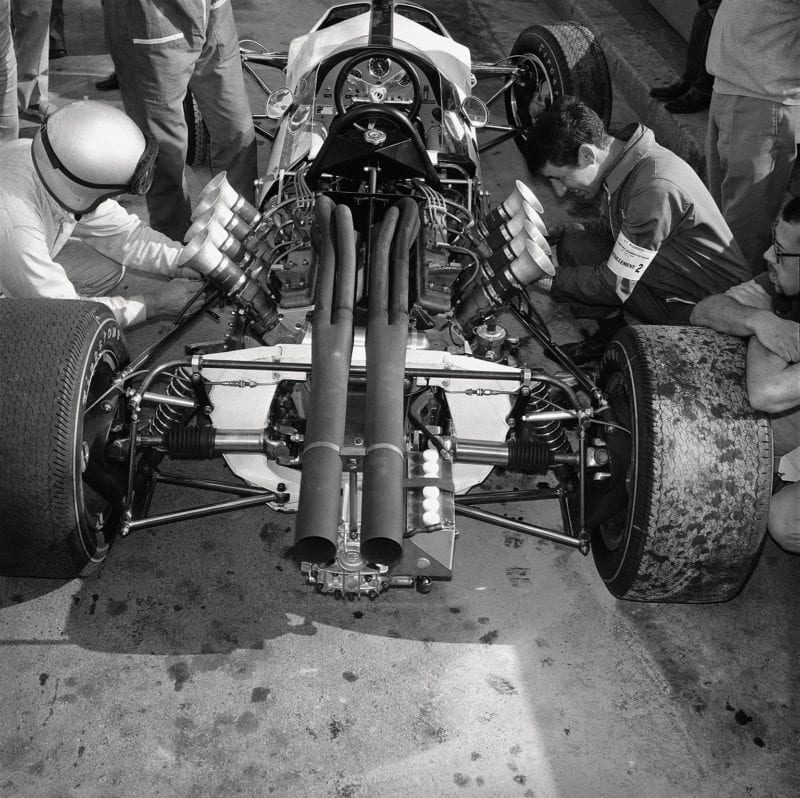
Bruce McLaren (left) and Ganley with M2B at Monaco 1966
Motorsport Images
“Ford had commissioned Bruce to build up the GT X1, a lightweight 7-litre GT40 roadster, using L72 aluminium for the monocoque instead of steel. Gary Knutson came over from Chaparral to work it up, and I was his right-hand man. When it was done we took it to America for Chris Amon to race, and I towed it all over, from Canada to California. After Riverside I took it down to the Bahamas for the Nassau Speed Week, back up to Kar Kraft in Dearborn, then down to Florida for auto transmission testing at Sebring. Somehow they’d got it into their heads that I knew about suspension and gearboxes. I didn’t know anything about anything. But in the land of the blind the one-eyed man is king, and maybe I had half an eye now.”
English-born Ken Miles was a key member of the Ford team. Having won Daytona and Sebring that year, he lost out at Le Mans in the stage-managed Ford 1-2 finish, and was killed six weeks later at Riverside, testing the new Ford J-car. “Ken was a pretty hard character, used to people jumping to his orders. Well, I’m a Kiwi, I don’t jump. So we didn’t get on very well at first, but between us we eventually got the X1 going seriously quickly. In March Miles and Lloyd Ruby won the Sebring 12 Hours in it. By now it was really tired, the L72 was brittle and I had to keep drilling holes at the end of cracks to stop them spreading. So after Sebring they crushed it.
“I was sent back to Kar Kraft to work on the J-car, which was quite advanced for its time with an aluminium honeycomb monocoque. Then Bruce said: ‘I need you back in England: we’re building an F1 car.’ They’d moved to Colnbrook by this time and Robin Herd was on board. The first one, the M2A, was used for tyre testing. The second, the M2B, used the 4.2 Ford Indy four-cam shrunk to three litres. In May we took it to Monaco. The McLaren marque’s F1 debut was a bit different to how they do things today. Johnny Muller and I towed the M2B down to Monaco on an open trailer behind an old Ford Fairlane station wagon with the car’s designer, Robin, sitting in the back.
“All this time I was focusing everything on my ambition to race, saving every penny I made towards my goal. So I decided to leave McLaren. The policy there was, if you left you couldn’t go back, and understandably Bruce wasn’t too happy with me. To keep earning I got a boring assembly job at Lola, and then Peter Revson, who was putting together a Can-Am team with Skip Scott, hired me. I knew him well because he was one of the Ditton Road Flyers, living in that notorious house in Surbiton with Amon and Mike Hailwood. Two McLarens were being built up for him at Colnbrook. A few faces were pulled when I walked back in there to finish off the cars, but Revvie smoothed it all over.
“That Can-Am stint was good money, and when I got home I had enough at last to launch myself as an F3 driver. I got a new 1967 Brabham BT21 plus Transit van and trailer, and painted it in proper NZ racing colours. It’s a myth that our racing colours are black: they’re green with a silver stripe, just as Oz colours are green with a gold stripe. Because I lived on start and prize money, I couldn’t afford to race much in the UK, but I travelled all over Europe from race to race, prepping the car, sleeping in the van. My lady friend Elaine polished the car, did the timing and heated the baked beans. Same in ’68, and by now I’d also started a gearbox business in my garage at home. Mike Hewland put lots of servicing work my way until I was employing six people, doing work for Fl, F2 and sports car teams, in premises rented from Frank Williams.
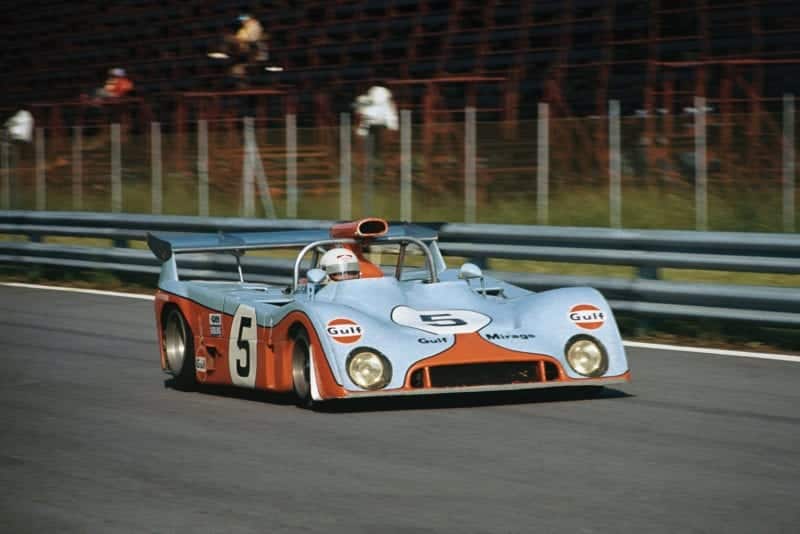
1973 season with JW Mirage included fifth at Osterreichring 1000kms with Derek Bell
Motorsport Images
–
I’d met Denny Hulme back home, doing gymkhanas in a rather flash red MG TF, and when I got to England he was working for Jack Brabham as a mechanic and getting the odd drive. When he first raced on the Continent with George Lawton [who was killed at Roskilde] they called themselves the New Zealand Racing Partnership, because if you had an important-sounding team name you got more start money. So Denny let me use it too. Despite his gruff reputation, I got on really well with Denny the Bear. Actually there were several bears: there was grumpy bear, but there was also kindly, soft bear. He was a good guy.
“At the end of 1968 I ordered a new Brabham BT28, but the delivery date was put back — Ron Tauranac was often slow to get his production going, because he was so fussy — and I heard of a cancelled order on a Chevron B15. I went up to the Chevron factory in Bolton, assembled the car, loaded it up and took it home. People reckoned the Brabham was more forgiving than the Chevron, which many said had an understeer problem. I just knuckled down to sort my B15 out, and learned to get the best from it.”
Howden’s 1969 season culminated in the F3 International on the Brands long circuit in October, against most of Europe’s F3 best. Penalised in his heat for a jump-start, he was 22nd on the grid for the 20-lap final. By lap four he was 11th, by lap 14 he was sixth, and on the last lap he got past Francois Cevert’s Tecno for fourth place. Into the final corner he attacked Bev Bond’s works Lotus for third and got a wheel on the grass, allowing Cevert to sneak past again. But his reward for this sensational drive was not just fifth place: he shattered the Brands F3 lap record at an average of exactly 100mph — just four years after Jim Clark had first achieved the same speed in an F1 Lotus. “It was a mental turning point for me. When you’re coming up there are some drivers you think, ‘Maybe this guy’s a bit better than me.’ Now I wasn’t afraid of anyone.
“Bruce used to ask me how things were going, and after that Brands race he said, ‘Come to Goodwood and have an F1 test.’ They had an M7C there for me and Reine Wise11 (who’d won the Brands race) and afterwards Bruce said, ‘We’ll run you in some of the non-championship F1 races in 1970. And I want to put you in a works Formula 5000 car. You don’t have to pay for it, it’s all done.’ He’d moved into a new house and his next-door neighbour, Barry Newman, had said, ‘I’d really like to sponsor a young driver.’ Bruce told him, ‘I know just the man.’
“The 1970 F5000 McLaren was the M10B. The production cars were made by Trojan, but the two quasi-works cars, mine and Sid Taylor’s for Peter Gethin, were built up at Colnbrook. Mine was dark green with the silver stripe again. It took me a while to get it working right, and we also had an oil problem — I was too stupid to realise the engine wasn’t scavenging properly — and Gethin dominated the championship in the other car. We had one win, five seconds and three thirds, and wound up second in the series ahead of Frank Gardner and Mike Hailwood. The Fl rides never happened, because at the start of June came the tragedy of Bruce’s death. It was totally devastating. But Bruce had built a fantastic team, with strength in depth, and everybody carried on, everybody knew what they had to do. That’s the mark of a great leader.
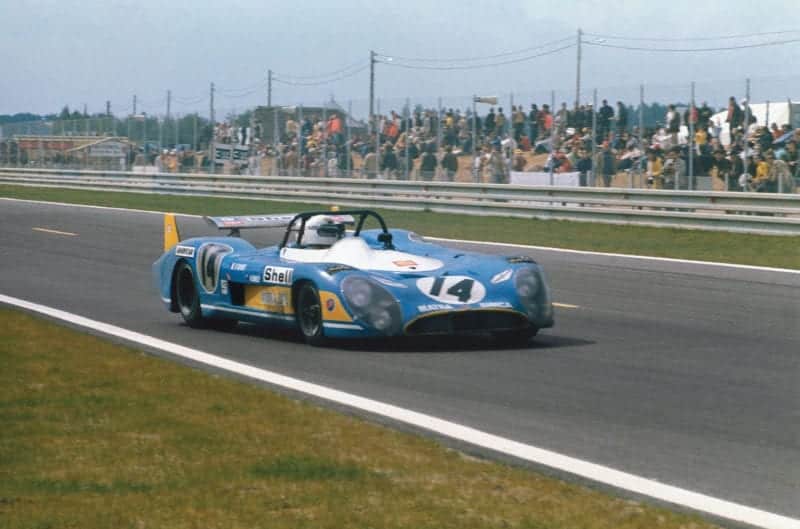
He enjoyed sharing Matra with Cevert at Le Mans 1972, where they finished second
Motorsport Images
“At the start of 1971 BRM gave me a test at Silverstone, and suddenly I was an F1 driver, number three alongside Pedro Rodriguez and Jo Siffert. As the new boy I saw their rivalry at first hand. Each was determined to beat the other. If I ever set a faster time than one of them in practice or in a test, the other was always delighted. They each wanted the new kid to put the other down. But they were both just wonderful characters, wonderful blokes. In July Pedro died in a private Ferrari in an Interserie race at the Norisring, and in October Jo died in the Fl race at Brands. That Christmas — the first time I’d been able to afford to go home for 10 years — my mother said to me: ‘Two out of three isn’t very good odds, is it?’
“Jo was killed by a mechanical failure. Most people were, if you look back. When I think of some of the accidents I had because of things falling apart… I can honestly say, apart from wrapping my Lotus Eleven round that power pole at Dunedin, I never had an accident because of driver error. And I had a lot of accidents.”
At the end of 1971 Howden was awarded the Von Trips Trophy for F1 rookie of the year. “My retainer was only £2000, but I also got 40 per cent of what the car earned, so if I managed to finish that could be a fair old slice. Louis Stanley was the boss, along with his wife Jean who was Sir Alfred Owen’s sister. Tim Parnell was team manager with technical input from Tony Southgate, who was a really great designer. The P153 was a good car, the P160 was better, and the P180 was better still. Aubrey Woods was the engine man. I would have been fourth at Silverstone but I got a puncture, and I was fourth at Watkins Glen. At Monza, of course, Peter Gethin’s BRM won the slip-streamer. I was fifth. In practice my engine was fantastic, and I qualified on row two. But after practice Tim decided to swap the engines around, and Gethin got mine. I still berate Tim for that.
“I didn’t get on very well with Big Lou while I was at BRM, although I had reason to appreciate him later. He had a permanent suite in the Dorchester Hotel, and he couldn’t sleep, so he liked to phone you at two in the morning, a very annoying habit. The problem was believing what he told you. When you were having tea with him he’d take himself off for a pee, and when he came back he’d say he’d just rung the engine shop at Bourne and they’d found another 20bhp. Adding all those pees together BRM should have had 200bhp more than Ferrari.
“Tony Southgate had designed a Can-Am BRM, the P154, but Pedro told him it was the worst car he’d ever driven. Tony said, ‘Well, Pedro has driven some real dogs in his time, so this must be bad. I’d better try again.’ He came up with the P167 which was brilliant, a completely different car. I did a lot of the early testing with it, and Pedro was meant to be driving it that fatal day at the Norisring, but because of last-minute engine problems the car didn’t go. Then Sid Taylor ran it in America for Brian Redman. When Siffert was killed the week before the Riverside Can-Am race Brian, who’d been Jo’s team-mate in the JW Porsche team, wanted to go to the funeral in Switzerland. I get a 2am phone call from the Dorchester: ‘Ganley, fly to California and drive the P167 at Riverside.’ I was going to Jo’s funeral too, but I asked myself, ‘What would Jo have done? He’d have gone racing.’ So I flew to LA.
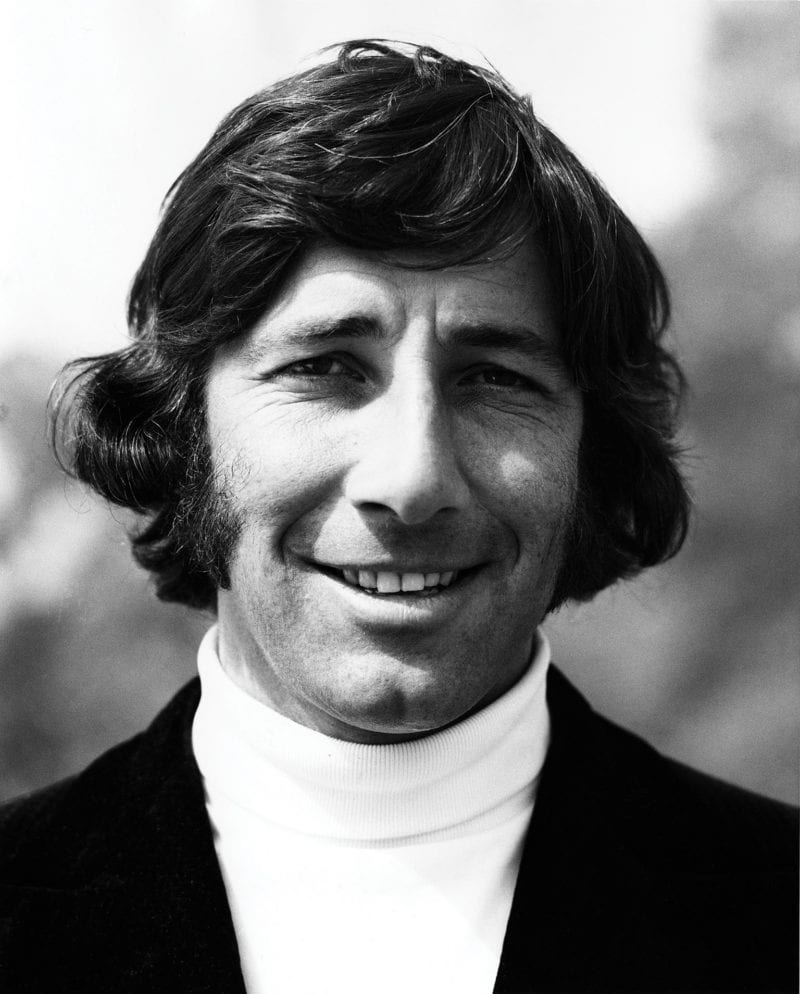
Howden in his prime
Motorsport Images
–
That was a special weekend. I was third in the race, and at a pre-race party Jackie Oliver said, ‘There’s a beautiful red-haired lady over there who wants to talk to you.’ So I went over to the beautiful red-haired lady, and in due course I married her.” This was Judy Kondratieff, a successful sports car racer: Sebring class winner and SCCA regional champion. She and Howden were inseparable soulmates for 37 years, until her sad death from ovarian cancer in 2007.
“For 1972 Big Lou had Marlboro sponsorship and decided to run an A team and a B team. The A team was Jean-Pierre Beltoise, Peter Gethin and me, and the B team was for local heroes and drivers who could pay. They’d run up to five BRMs in a race. Jean-Pierre had a weak arm from an old injury, and they had to take a lot of castor off the BRM. But at Monaco he scored a great win: in the rain the steering was lighter, and he didn’t get so fatigued. I was fourth at the Niirburgring. I loved that place, even though it did bite me two years later. My favourite tracks were old Niirburgring, old Spa and Monaco, then the Osterreichring.
“In 1972 I did Le Mans for Matra. That was a fantastic team. We tested at Ricard, running through the night, and it kept breaking down. But eventually we managed 20 hours, then 24, and finally we kept it going for 27 hours. In the race the 670s were driven by Graham Hill/Henri Pescarolo, Amon/Beltoise, and Francois Cevert and me. Chris never got in his car — it lasted one hour — but Graham and Pesca won and we were second. Francois was a really wonderful guy. I was shocked when he was killed in 1973. You develop a shell when you’re racing: even when your own team-mates die, you compartmentalise and carry on. But when you share a car in a longdistance race you really work together, you have a bond. That’s even harder.
“For 1973 Big Lou was giving me the royal treatment, offering me the Team No 1. I said to him, ‘What about Beltoise? What about Gethin?’ ‘Never mind about them, I want you to be the team leader.’ But Ronnie Peterson, who knew the Italian interpreter Big Lou was using, tipped me off that he’d offered the same deal to Clay Regazzoni. There were too many shifting goal posts. There’d been some talk of joining Chris at Matra, but they withdrew from F1. March looked a possibility, but I fell out of that equation. The next best game in town seemed to be Frank Williams and the Iso Marlboro.
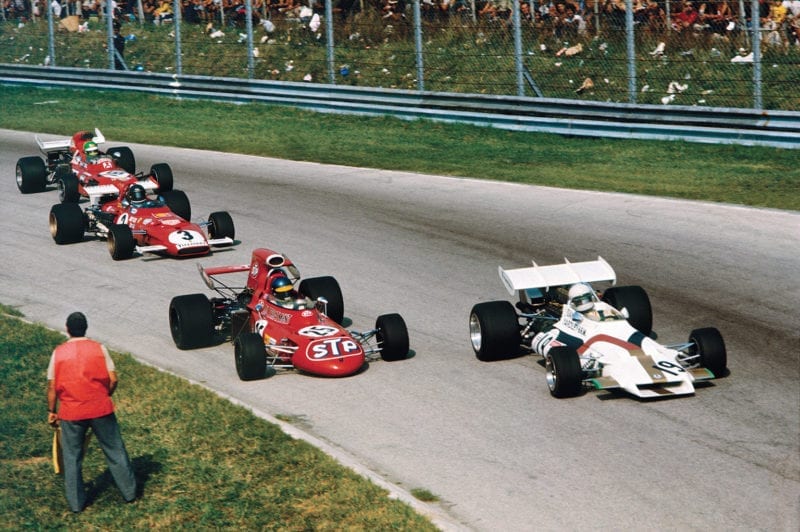
Ganley leads Peterson (March), Ickx (Ferrari) and Pescarolo (March) at Monza 1971 en route to fifth
Motorsport Images
“At the time Frank was desperately trying to keep his show on the road. He didn’t have enough sponsorship to start with, now he had half of not enough. I tried very hard to take Tony Southgate with me from BRM, but Tony knew Frank didn’t have enough budget, and he was wooed by Don Nichols at Shadow. I tried to get Mike Pilbeam from BRM, but with Tony’s departure he’d just been made chief designer. So Frank got John Clark from March, and employed three fabricators known collectively as the Flowerpot Men. The car overheated and the fuel system didn’t work. But I got stuck in and by Monaco we were getting somewhere, and I qualified it on the fifth row. Then all the changes I’d made got taken off. In Canada there was chaos when they tried to use the pace car for the first time in a Grand Prix, followed by a confusion of pitstops, and the official lap charts blew up. At first they reckoned I’d won: that evening they decided I was sixth. Actually I’m pretty sure I was third.
“Since 1972 I’d been building my own F1 car, a monocoque with ground-effects and pull-rod suspension. I was going to run it for myself. I had two DFVs, transporter, all the equipment, and I’d started on a second chassis. When Marlboro were unhappy with how the Iso was going I said, Tay me what I’ve put into my F1 car and give it to Frank.’ But it didn’t happen. Frank said, ‘I’m not having you taking over my team’, which wasn’t what I was trying to do.
“I had a two-year contract with Frank, but at the end of 1973 we’d rather fallen out with each other. There were some money problems, and there didn’t seem to be a willing buyer or a willing seller between us. A March drive was available, and I felt comfortable with Robin [Herd] and Max [Mosley], they’d used me for testing quite a bit. I did Argentina and Brazil, then Vittorio Brambilla came along with Beta Tools money, and I was out. But I did do a full sports car season with the JW Mirage team, usually paired with Derek Bell. The Ferraris and Matras were fastest that year, but we were second at Spa — I was with Vern Schuppan that time — and fourth at Watkins Glen.
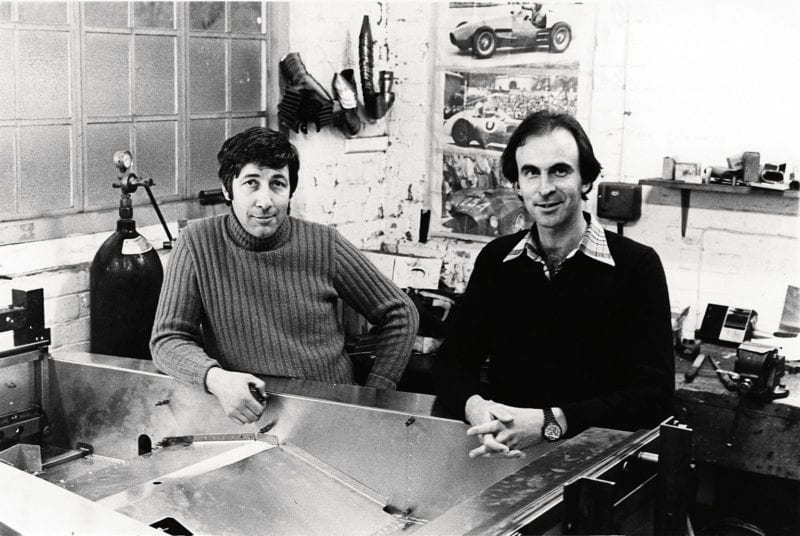
Howden still has the parts from his own F1 car, which almost became the Tiga F1 when he ran the marque with Tim Schenken
Motorsport Images
“Then I had a mysterious phone call from an oriental gentleman asking to speak to Mister Ganrey. I thought it was Tim Schenken winding me up, but this guy said he represented a new Japanese F1 team called Maki, plenty of financial backing, four chassis and eight engines. ‘Very nice,’ I said. ‘Who’s the other driver ?”Oh no, Mister Ganrey, all for you.’ It turned out they did have four chassis, but only one engine. And no premises, so I had to rent them some space I had. The cars didn’t even comply with the F1 rules, the bodywork was all wrong, and I had to get them to change it. We went testing and testing and testing, pounding round Silverstone and Goodwood. I’d come in and say, ‘Let’s try stiffer springs on the back’, or ‘Let’s try a couple more degrees on the rear wing.’ Then I’d go out again: no difference. I started watching the mechanics in my mirrors, and they were ignoring me. In the end I blew my top, and then they followed all my suggestions — moved the radiators back, made a proper airbox, cleaned up the airflow around the rear wing. First race was to be the British GP, but Thursday’s final session was almost over when the Maki transporter rolled into the Brands paddock. On Friday we did a time which on Thursday would have got us in the race, but by then the others had improved. So DNQ.

Maki arrived late at Brands for 1974 British GP and failed to qualify
Motorsport Images
“I gave them another lecture, and two weeks later at the Niirburgring the Maki was at the head of the line, all warmed up, ready for first practice on Friday. About a kilometre into my first lap, after the fast downhill right-hander, the rear suspension broke. The car turned into the guardrail and the front disintegrated, leaving my legs sticking out for the rest of the accident while it took another whack at the barrier. When it stopped there was fuel spraying everywhere. Somehow I got myself out and to the side of the road. Both my legs and one ankle were broken, but the real damage was to my feet because all the little bones were fragmented.
“In the race Mike Hailwood had his big shunt, so we both ended up in the Krankenhaus. This is when I learned to appreciate Big Lou. He got a helicopter to land outside the hospital, flew Mike and me to Cologne, persuaded British Airways to take two stretchers on a scheduled flight, met us at Heathrow, got us to St Thomas’ Hospital and laid on the great Mr Urquart — the surgeon who’d looked after Stirling Moss and John Surtees after their big accidents. Urquart’s technique for rebuilding bone was, if you can stand the pain you should walk on it. In 16 days I was hobbling around St Thomas’. But it was nine months before I raced again, ironically at the Niirburgring, driving a Loos Mirage in the 1000Kms with Tim Schenken. I still couldn’t push the brake pedal properly, but we were leading until we had to make an extra fuel stop at the end. One of the works Alfas beat us by 29sec after nearly six hours’ racing.
“At the end of 1975 somebody asked Schenken to invest in a project to build Formula Fords. He showed me the proposal, and I said, ‘This looks rather good. Why don’t we do it ourselves?’ That was the start of Tiga — the name came from TIm and GAnley. At first it was just me and Tim and Martin Reid. When we outgrew my shop we took over the old Fittipaldi place in Reading. We built Formula Fords and Sports 2000s, Formula Atlantics, C Sports for America, two Can-Am cars, 33 Group Cs, some Formula Ks for Mexico. By 1986 we’d delivered over 400 cars, but I was working much too hard, seven days a week, and it was time to sell up. But I’m very happy I did Tiga. There are still a lot of the cars out there.
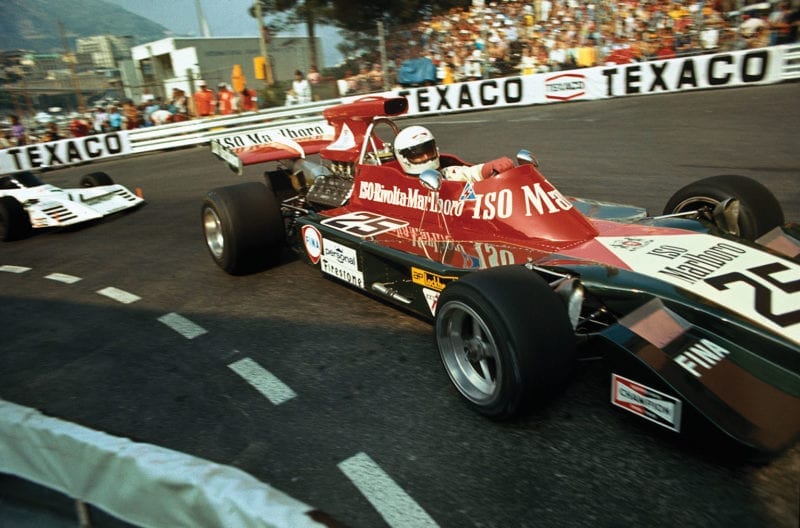
Monaco provided sole high in difficult season with Iso Williams in 1973
Motorsport Images
“We nearly resurrected my F1 car as the Tiga F1. In 1977 F&S Properties were sponsoring Boy Hayje and Mikko Kozarowitzky in RAM Marches and failing to qualify everywhere, and they talked to us about our car. But they ran out of money and it didn’t happen. I’ve still got the F1, broken down into little bits and stored. One day before I die, perhaps I’ll put it all together.
“After Tiga I was elected onto the board of the BRDC, and became a director of Silverstone Circuits and Silverstone Estates as well. When John Fitzpatrick left in 1998 they asked me to be club secretary. I didn’t do that for long, because Judy was diagnosed with cancer, but when I resigned from the boards they did me the great honour of making me a vice-president.”
All of which is a long way from Hamilton, writing race reports for local papers. Through succeeding stages of his long career Howden earned respect as mechanic, engineer, racer, development tester and designer. “I’ve been very lucky. I never won a Grand Prix, so my schoolboy dream didn’t all quite happen. But a lot of it really did come true.”
